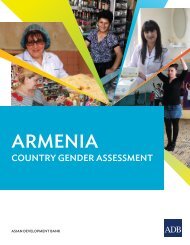Civic Activism as a Novel Component of Armenian Civil Society
English-3
English-3
You also want an ePaper? Increase the reach of your titles
YUMPU automatically turns print PDFs into web optimized ePapers that Google loves.
mentioning a few key points here to underscore the difference between these two types <strong>of</strong> civil<br />
society actors.<br />
Unlike NGOs, civic activist groups maintain minimal levels <strong>of</strong> formal organisation. They<br />
do not opt for becoming legal entities through state registration procedures. Membership,<br />
leadership and decision-making rules are simple and b<strong>as</strong>ed on unwritten, informal conventions,<br />
acceptance and mutual understanding. In this respect, civic initiatives are more akin to social<br />
movements than to <strong>as</strong>sociations.<br />
Another major difference between NGOs and civic initiatives is the focus <strong>of</strong> their main<br />
activities. While NGOs have mission statements and are<strong>as</strong> <strong>of</strong> expertise, these are usually fairly<br />
broad. <strong>Armenian</strong> NGOs <strong>of</strong>ten engage in a number <strong>of</strong> varied projects that loosely connect to their<br />
mission; drifting focus are<strong>as</strong> (<strong>of</strong>ten in response to chance changes in donor preferences) is not<br />
uncommon. <strong>Civic</strong> initiatives, by contr<strong>as</strong>t, are mostly very narrowly targeted at one specific issue.<br />
They have a clearly defined goal (to preserve one particular park, for example). Once the issue is<br />
resolved, the civic initiative in question ce<strong>as</strong>es to exist. Of course, the individual network does<br />
not disappear overnight. The same people are likely to take up another campaign in a similar (or<br />
a different) field. One <strong>of</strong>ten sees the same people <strong>as</strong> core activists in various campaigns (Bagiyan<br />
2015; Kankanyan 2015).<br />
The third and perhaps most defining difference between NGOs and civic initiatives is that<br />
grants are the lifeblood and the modus operandi <strong>of</strong> NGOs. Most <strong>of</strong> them do not even consider the<br />
possibility <strong>of</strong> becoming self-sustainable and moving away from grant-earning and implementing<br />
cycles. Grants from international development organisations are actively sought and considered<br />
prestigious. <strong>Civic</strong> initiatives, by contr<strong>as</strong>t, explicitly reject foreign funding. They aim at being<br />
self-sustaining at any given point in time, undertaking only those activities that they can<br />
implement through volunteer commitment and minimal fundraising among members.<br />
Thus, contemporary <strong>Armenian</strong> civil society is richer than it w<strong>as</strong> ten years ago. <strong>Civic</strong><br />
initiatives have entered the civil society arena and brought distinct ways <strong>of</strong> organising and<br />
operating. Our research project examines the interplay between the ‘old’ NGO sector and the<br />
‘new’ civic activism, using a range <strong>of</strong> methods, which are discussed in the next chapter.<br />
III. Methodology<br />
The goal <strong>of</strong> the research project, described in this manuscript, is to study the interplay between<br />
NGOs, <strong>as</strong> the older elements <strong>of</strong> <strong>Armenian</strong> civil society, and civic initiatives led by activists, <strong>as</strong><br />
the new actors in the civil society arena. The aim <strong>of</strong> the project is to answer the following<br />
research questions:<br />
RQ.1: How do NGOs and activists perceive one another?<br />
18



